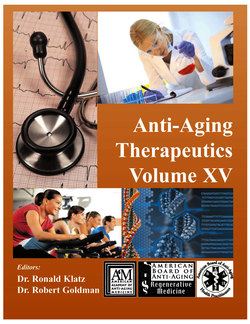Читать книгу Anti-Aging Therapeutics Volume XV - A4M American Academy - Страница 20
На сайте Литреса книга снята с продажи.
The Clinical Anti-Aging Setting
ОглавлениеMost traditional endocrinologists have had no intense training in treatment of testosterone and growth hormone deficiencies. They generally have excellent training in the treatment of diabetes, but lack of interest and expertise in how to treat testosterone and adult growth hormone deficiencies and some other hormone deficiencies that may accelerate aging. Because of this lack of knowledge, many of them have rejected these treatments and confused them with the improper use at excessive doses by sports athletes searching to improve their performance. The A4M, its numerous worldwide affiliated scientific and medical societies, and befriended organizations, do not approve the improper use of these substance in sports, but do point to the right of every patient who is suffering from one of these deficiencies to get relief from their complaints by the adequate hormone treatment.
Critics of the anti-aging medical science do acknowledge that HGH prescribing is perfectly legal in connection with (1) "treatment of a disease" or (2) an "other recognized medical condition" that has been authorized by FDA. At no time has Congress evinced any intent to restrict ethical physicians from prescribing HGH to mature or elderly adults for medical reasons within their sound judgment. Nothing in the statute dictates to physicians how to diagnose the indications for diseases which may be treated by HGH. Any inference that the statute was intended to prohibit physicians from prescribing HGH for hormone replacement purposes in GH-deficient adults is, in A4M's view, misplaced.
The therapeutic value of HGH was validated by a study83 conducted in Stockholm, Sweden. Data concerning visits to the doctor, number of days in hospital, and amount of sick leave were obtained from patients included in KIMS (Pharmacia International Metabolic Database), a large pharmacoepidemiological survey of hypopituitary adults with GHD, for 6 months before GH treatment and for 6-12 months after the start of treatment. Assistance required with normal daily activities was recorded at baseline and after 12 months of GH therapy. Quality of life (QoL) (assessed using a disease-specific questionnaire, QoL-Assessment of GHD in Adults) and satisfaction with physical activity during leisure time were also assessed. For the total group (n = 304), visits to the doctor, number of days in hospital, and amount of sick leave decreased significantly (P < 0.05) after 12 months of GH therapy. Patients also needed less assistance with daily activities, although this was significant (P < 0.01) only for the men. QoL improved after 12 months of GH treatment (P < 0.001), and both the amount of physical activity and the patients' satisfaction with their level of physical activity improved after 12 months (P < 0.001). In conclusion, GH replacement therapy, in previously untreated adults with GHD, produces significant decreases in the use of healthcare resources, which are correlated with improvements in QoL.
